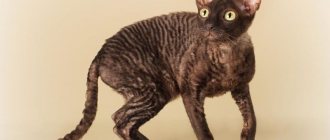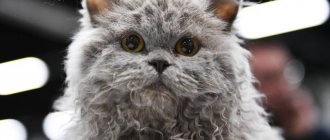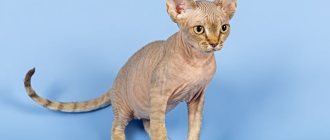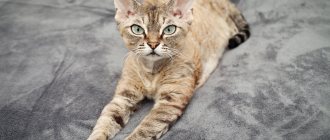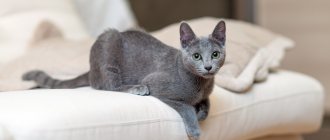There are several types of cat breeds in the world called Rex. This means that they have an important distinctive feature - curly hair. Depending on the history and place of origin, a prefix is added, and today we will talk specifically about the Ural Rex breed. As the name implies, it originated in our homeland, and under what circumstances you will find out further. It will be no less interesting to read about what else, besides the specific fur coat, distinguishes this unique family.
History of origin
The founder of the rare Ural Rex breed is the kitten Vaska, born in a natural environment from a straight-haired cat and a cat who wished to remain anonymous. The action took place in the late eighties in the small town of Zarechny, which is in the Sverdlovsk region. It was this chance connection that marked the beginning of the era of the revival of unusual animals.
The Ural Rex was born for the first time in the Sverdlovsk region
Why the revival, you ask? The fact is that some sources mentioned the existence of cats with a similar appearance. They allegedly met in the 30s in the Urals. But apparently the war turned out to be too merciless, and they were practically wiped off the face of the earth. That is why the official date of appearance of the Ural breed is considered to be 1988.
To continue the family line, Vaska was crossed with her mother, and it was with their offspring that breeders began active work to improve this gene. An experiment was also conducted to cross the Ural Rex with the Bohemian Rex and the Cornish Rex, but it was unsuccessful because the litter was straight-haired. This gave rise to the conclusion that they can only be brought together within the breed.
Interesting Facts
Despite the youth of the Urals, interesting facts have already appeared about the breed:
- To improve the Ural cats, breeders bred them with Bohemian and Cornish Rex. But as a result, the kittens had straight hair. Thanks to these experiments, it became clear that these breeds have different “curl genes.”
- The waviness in the coat of the Ural Rex appears earlier than in other curly-haired cats. Curls become noticeable by 3-4 months. And by the age of six months, Ural residents develop curly waves.
Purchasing a kitten
Buying a Ural Rex kitten in Russia is quite simple. But, like other representatives of rex breeds, Uralians are relatively expensive. The exact cost of a kitten depends on the age, gender, appearance and class of the animal. A kitten for the “soul” (pet class) will cost over 15,000 rubles. A cat for future breeding (breeding class) will cost up to 50 thousand rubles, and for a future champion and title holder you will have to pay more than 50 thousand rubles.
To buy a good Ural kitten, you need to contact only specialized nurseries. The best cattery is an organization that breeds only one breed (even if the entire cattery consists of just one cat). If cats of several breeds are bred in one place, then most likely the goal of these people is to sell kittens that are similar to purebred ones.
The price of a kitten depends on several criteria: class, age, gender
How to choose a good kitten
When choosing a kitten in a nursery, you need to be guided by several criteria:
- appearance (the animal must be neat and well-groomed, without visible wounds, scratches, discharge from the eyes or nose);
- absence of skin parasites (you can part the fur with your fingers; there should be no fleas or their excrement on the skin and fur);
- the kitten’s behavior (the baby should be cheerful, moderately active and friendly);
- availability of documents (the animal must have a veterinary passport indicating all vaccinations: against calcivirosis, panleukemia, etc., as well as a pedigree);
- breed characteristics.
It is believed that all little kittens are alike, but you must be sure that you choose a real Rex. Even the smallest Uralian should show signs of the breed . These kittens are born already curly, however, the curly hair forms into even waves by six months. At the same time, the guard hairs remain soft to the touch (as if thinned). The fur of kittens has a grayish, gray tint. Later, the rex's fur will oxidize and take on a golden hue (especially in black and red rexes).
The Rex kitten has a well-defined cranial part of the head, the eyes are bulging and widely set, and the nose is wide. The kitten's muzzle is an inverted triangle; the high cheekbones are especially visible. Otherwise, the body of the little Uralian differs little from the constitution of representatives of other breeds.
Video: little Ural kittens
Suitable age to purchase
Many people want to adopt a very young kitten, but few dare to tear the baby away from the mother cat. Next to its mother, the kitten feels protected. The cat feeds it, and with colostrum the kitten receives primary immunity. A baby who is separated from a cat too early may be mentally vulnerable, ill, and have behavioral problems. Such animals can damage furniture, walk past the litter box, and generally disobey their owner.
The kitten tries to imitate its mother in everything, which is why it is so important to let the kitten learn all the skills from the cat. This is necessary so that the animal begins to eat properly, go to the litter box, and communicate with its relatives. Only by two months does the kitten begin to sense moderation in play, controlling the force of its bites and not scratching its comrades.
At about 2 months, the primary immunity received by the kitten from its mother begins to decline. At this time, they begin to prepare the baby for the first vaccination. Kittens are not vaccinated until they are 3 months old, and if they are brought into a new home without immunity, the baby runs the risk of getting sick. In unusual conditions, the animal’s body can be attacked by viruses and infections. There was a case in my family when we had to take in a very small kitten who was left without a mother. He fell ill, suddenly began to feel unwell and took ill. Of course, we immediately called the vet, but the cat died anyway. The veterinarian said the cause of death was distemper.
You cannot separate a kitten from its mother until it is 3 months old.
Breeding
When breeding, only matings are carried out within the breed. There is a risk that the gene that makes the coat curly may not be expressed. Due to the small number of Ural Rexes, finding a partner can be difficult.
If the goal is simply to get beautiful kittens, then any partner will do, but for professional breeding he must be selected very carefully.
If the goal is simply to get beautiful kittens, then any partner will do
To ensure the purity of the breed, do the following when mating:
- contact the nursery where the kitten was adopted;
- based on recommendations, look for another nursery;
- contact independent experts who can help in selecting a partner.
Mating and partner selection
Puberty in the Ural Rex occurs at 9 months, but they try not to breed cats until they are one year old. The first mating can take a year and a half - this is normal. Cats are subjected to this procedure at a younger age - they do not have to strain their bodies by bearing offspring and giving birth.
The mating process takes about 5 days. The cat is brought to the cat.
When choosing a partner for mating, pay attention to the following signs:
- absence of traces of fleas and diseases on the body;
- mating experience;
- purity of the breed (presence of pedigree);
- attractive appearance.
It is better to choose a partner similar to a cat. If the parents have different colors, the color of the offspring can be unpredictable.
The mating process takes about 5 days
When mating, the phenotype of the line can be adjusted - a cat with short hair is mated with a cat with long hair. Then the owner takes such a long-haired kitten to the nursery to introduce fresh genes.
Pregnancy and childbirth
This is largely due to the natural origin of the breed. On average 2-4 kittens are born. Maternal instincts are clearly expressed, and in both male and female cats - the fathers of the family are actively involved in caring for the kittens.
Be sure to read:
How to choose a kitten that looks like a leopard - Bengal breed: photo, price, description?
Description of the breed
Despite the fact that the Ural Rex cat appeared quite recently, she showed her best side.
Yes, she had the blood of farm animals in her roots, but this did not stop her from becoming an elegant and intelligent representative of her species.
And perhaps this is what gave them good health with strong immunity.
Typically, individuals do not grow too large in size and are not prone to being overweight. Their fur is like velor, without undercoat, and practically does not shed, which is very much appreciated among cat lovers. When they are born, from the very first days they have a curly coat on their body, which soon straightens out. But closer to the age of puberty, after six months, it begins to curl again, and with it the eyebrows, mustache, and beard. Despite their direct relation to the Rexes, they are still different from all of them. The structure of their coat and its density are different, and if you touch two different representatives of this family, you can feel a real difference.
Owners always note that their pets are obedient and understanding, and do not strive to break the rules established by the owner or cause chaos in the apartment.
The description of the Ural Rex breed cannot but be supplemented with information about the intellectual abilities of its representatives.
Castration and sterilization
Ordinary people often use the terms castration and sterilization in relation to the sex of an animal. We are accustomed to thinking that only males are castrated, and cats are sterilized. However, you need to know that using these concepts in this sense is incorrect. In medical practice, these two operations are not gender specific:
- castration is the removal of reproductive organs in animals: in males the testicles are removed, and in females castration can be partial - only the ovaries are removed or complete - the ovaries are removed along with the uterus;
- Sterilization is an operation that removes reproductive organs from female animals and removes testes from male animals.
There is no consensus regarding the best age for these operations. It is believed that the optimal time for the cessation of reproductive functions is the age of 7–8 months, that is, before the animal becomes sexually mature. Some veterinarians believe that it is better to perform these operations at an even earlier age.
It is better to carry out the operation before the animal reaches sexual maturity.
Character
When talking about the Ural Rex breed, character is put almost in first place, because in combination with its extraordinary appearance, it turns out that this is a real velvet angel. He is moderately playful, cheerful and inquisitive. His friendliness can be the envy of any breed, because every mustachioed Ural resident will find a common language with anyone, be it a member of a human family, a child, a guest, a judge at an exhibition, another cat, a rabbit or a dog.
The Ural Rex is a breed of loyal, obedient and affectionate cats
The Ural Rex cat is very attached to its owner. He will make you happy if he notices sadness in your eyes, “heal” you when he feels your pain, or will happily join you in the game, if you are in the right mood. Human attention and love are important to him, so he should not be left alone for a long time.
If you are planning to get a show-class Ural Rex and are going to take part in exhibition events, then this is an excellent option, because they are diligent, calm and easily endure all the difficulties of such competitions.
External data
External characteristics of the Ural Rex breed:
- Average body size, distinguished by a muscular structure, but at the same time retains slimness and roundness in the chest and torso;
- The head is in the form of a wide triangle with rounded corners. The forehead is massive and convex, the cheekbones are set low, and there are plump cheeks due to the protruding mustache pads. The chin, although narrow, is also powerful;
- Against the background of a small muzzle, large eyes, shaped like almonds, are clearly visible. They are located at a great distance from each other, stand obliquely;
- Between them there is a wide, but not long, and straight nose;
- The ears stand out from the general background because they are triangular, high and straight. There is a noticeable rounding at the tips;
- The paws of animals are of medium length, thin, but stable;
- The tail is thin and also wavy, like the whole body;
- The coat is short, curls are finally formed closer to the year.
Ural Rex kittens are born with curly fur, which subsequently straightens and then curls again.
Officially recognized breeds of cats with curly hair
German Rex
German Rex cats
The first kitten appeared in the distant 30s of the last century from Russian Blue and Angora cats. The breed received official status in 1970.
These are medium-sized cats, strong, muscular with a rounded head, medium-sized ears that are wide with rounded corners. The fur of these cats is slightly curly, very soft, reminiscent of plush.
Representatives of the breed are distinguished by high intelligence and a friendly disposition; they get along well with children and any animals in the house.
Cornish Rex
Cornish Rex cats
The breed has officially existed since 1950; it appeared in Britain, when a strange baby with thin long legs, a small wedge-shaped head, large ears and a curly fur coat appeared among ordinary kittens on one of the farms there.
The owner gave the cat to breeders, and they began breeding; the breed was recognized by all felinological organizations only in 1983.
The Cornish Rex is an incredibly active and agile breed (you need to be prepared for this), they are affectionate, intelligent and friendly. Despite their external fragility, Cornish dogs have strong bones and developed muscles; they have very soft short hair that resembles velvet to the touch.
Devon Rex
Devon Rex cats
The breed also appeared in England in the 60s. Initially it was believed that it was a subspecies of the Cornish Rex, but it turned out that completely different genes create the curly hair in these cats.
These cats have, in truth, an alien appearance: medium size, graceful flexible body, fairly large and slightly slanted eyes to match their color, and a wedge-shaped head. But the real feature of the breed is the huge ears, set as deeply as possible and widely spaced, with a wide base and a rounded tip. Six is very soft, short with a slight “wave”.
If you have been dreaming of a long-eared friend with a unique appearance, then this breed is ideal. These are smart cats, they are quite active and affectionate, but they do not like children too much, focusing more on adults.
Selkirk Rex
Selkirk Rex
This breed originated in the USA in 1987: it all started with a cute curly-haired stray cat, she was crossed with a Persian cat. Further, Persians, exotics and British cats participated in the breeding of the breed; the breed received official status in 1992.
The main feature of the Selkirk is its unique coat; it combines very curly, straight and wavy hairs, so the cat overall looks like a lamb. The coat is plush and very soft, and can be either long- or short-haired.
By nature, these are very affectionate, calm cats with high intelligence.
Laperm
This breed appeared in the USA by accident: an unusual kitten was born on a farm: at first he was bald, and then acquired a curly coat. The breed was registered in 1997.
The main difference from other curly cats is the coat; it can be simply wavy or curl into tight curls, hence the name of the breed from the combination “perm.”
Representatives of the breed are very friendly, moderately active and love company.
Ural rex
Ural Rex cats
A young domestic aboriginal cat breed, appeared in 1988, officially recognized in 2006.
These cats have a slender, flexible body, small ears, a wedge-shaped head and wide-set eyes. Their coat is soft, curly, and their hair is short or semi-long.
Choosing a kitten
The kitten must be purchased from a trusted nursery or from breeders with a good reputation. If necessary, contact one of the clubs - they can recommend a suitable seller.
When visiting in person, make sure the kittens are healthy and active. They should have clear, clean eyes, healthy skin and coat.
When purchasing a show-class animal, keep in mind that the appearance of the Ural Rex is finally formed only at 1.5–2 years, and at 3 months even the best expert can only make a preliminary assessment.
The breeder must provide:
- kitten's pedigree,
- vaccination certificate,
- contract of sale.
Responsible breeders also provide information support and advise new owners on all issues that arise.
Due to the peculiarities of their fur, Ural Rex cats provoke allergies to a much lesser extent than most other breeds. However, they cannot be called completely hypoallergenic, and such statements from the breeder are deceit, which should alert you when choosing a seller.
If for some reason you are not sure that this is a Ural Rex, pay attention to the following signs:
- The Cornish Rex has a graceful and slender body of the Oriental type. The Ural team has a denser and more athletic body.
- Devon Rexes differ in the size of their ears. Among the “Uralians” they are medium, but among the Devons, according to the CFA description, they are “strikingly large”, very wide at the base. In addition, the “Uralians” have almond-shaped eyes, and the Devons have oval eyes.
- The difference with the German Rex lies in the shape of the head - the “Germans” have it almost round, the “Urals” it is triangular.
- Selkirk Rexes are easily distinguished by their slightly flattened muzzle, which indicates their relationship with Persian cats.
Pet-class kittens with flaws that are not dangerous to health will cost 15–35 thousand rubles. Breed class is estimated at 25–45 thousand rubles. Finally, a show-class animal, potentially capable of winning titles, will cost 35–50 thousand rubles.
Color
You can find various photos of the Ural Rex cat with any combination of colors. But there are recognized standards that stipulate the following rules:
- The uniform coat color of this breed is available in white, red, blue, cream, black, gold and silver;
- Any combination with white is allowed, mainly bicolor, tortie with blue or black, tortoiseshell, van, tabby or harlequin.
However, there are a number of restrictions, for example, it is unacceptable for the Ural to have a chocolate shade, cinnamon color, ticking or Burmese color.
Ural rex black
Health
This cat breed has strong immunity.
Curly-haired beauties do not have a tendency to diseases that are inherited.
Important! Ural Rex kittens need vaccination , which is carried out at the age of 4 months. Then they need to be vaccinated to protect pets from various types of infections and diseases like distemper . Sometimes kittens are treated for ticks .
In the future, measuring its temperature will help determine whether a Ural Rex cat is healthy or not.
The latter should be no higher than 38.5 °C. These animals mainly suffer from:
- intestinal diseases;
- bladder problems;
- common cold.
If your rex is diagnosed with a disease that requires anesthesia to treat, remember that the dosage should be small.
There are reviews that these cats have difficulty recovering from anesthesia.
You should also be careful when using sedatives.
Before you buy them for Urals, discuss the use of medications with your veterinarian in advance.
You need to show your pet to a veterinarian 1-2 times a year. This will prevent possible health problems
Peculiarities
This cat has a number of points that most fully characterize this breed:
- Curly nature of the coat. The density of the curls is determined by the length of the coat.
- Cats have proven themselves to have wonderful personalities.
- The breed is characterized by excellent health.
- At birth, kittens have a gray tint, which disappears without a trace after the first moult.
- If the cat is black, then when it reaches the age of two years, a change in color occurs. A characteristic golden hue appears.
- Cat fur does not cause allergies. For this reason, the breed is suitable even for those who are prone to allergic reactions.
Scottish Fold cat - description of the breed
Care and maintenance
As mentioned earlier, the Ural Rex breed is very strong and healthy. She has no genetic predisposition to diseases. The coat is short, there is no undercoat, which means there is no need for combing, and the house will always be clean. In addition, these cats are recommended for allergy sufferers.
Their only drawback is dry skin, so bathing animals is not advisable at all. It is better to use a soft, damp cloth, or due to urgent need.
Do not forget to clean the ears and trim the claws, but this is not done too often, but a couple of times a month.
In terms of feeding, there are no difficulties here either. Ural rexes are not picky eaters; they can easily live on a natural diet, the main thing is that it must contain cereals, proteins and vegetables (all in equal proportions).
The Ural Rex is not a whimsical animal; it doesn’t even need to be combed.
Feeding the cat
Urals are unpretentious in food, so you can feed them both industrial and natural food. The main thing is not to mix these types of nutrition with each other.
When feeding dry food, Uralians buy premium or super-premium products from trusted manufacturers. It is important to ensure that it does not contain any dubious additives such as soy, dyes and preservatives.
The following brands of food are best suited for residents of the Urals:
- Bosch;
- Hills;
- Pronature;
- Gemon.
With a natural type of food, a cat's diet should consist of 70-80% meat. The Ural resident is also given:
- boiled vegetables;
- porridge with water;
- offal;
- boiled eggs;
- dairy products;
- oceanic or sea fish of low-fat varieties.
Bread, sausages, sweets, mushrooms and smoked meats are excluded from the Ural Rex’s diet. Also, a cat of this breed is not given pork, beans, exotic fruits, or any leftovers from the owner’s table.
How to care for the Ural Rex
Despite its exotic appearance, the Ural Rex does not require complex care. Cleaning the ears as they become dirty, brushing the teeth once every 7–10 days and trimming the claws once every 2–3 weeks should be done in the same way as for cats of other breeds. The peculiarity of caring for the Ural Rex lies in the uniqueness of their coat. Dead hairs in Ural cats do not fall out on their own, as they get stuck among the curls, so weekly combing of these cats (1-2 times every 7 days) with special combs should become a habit. During the shedding period, brushing should be done every other day. Soft brushes with natural bristles or a comb with short teeth that do not damage the hair structure are well suited for these purposes.
To achieve shine on the wool, you can wipe it with a suede piece of cloth or a suede mitten.
Ural Rexes should be bathed as rarely as possible, only when their fur becomes dirty, since their skin is very delicate. According to reviews from Rex owners, shampoos such as 1All systems, which improves coat texture, and 8in1 Perfect Coat SHED CONTROL & HAIRBALL SHAMPOO can be distinguished.
Ural residents need to be bathed rarely, using special shampoos
Toilet
Ural Rexes are very smart cats, so litter box training is usually not very difficult. They are also not picky about the container and cat litter. The main thing is that the kitty fits comfortably in the tray. Therefore, the owner can independently choose a more convenient option for himself and his pet.
Feeding
You can feed the Ural Rex both natural products and ready-made industrial feeds. When choosing the latter, you need to remember that budget food (both dry and wet) is not suitable for this breed of cat. For them you need to choose premium and super premium food. For example, ROYAL CANIN, JAMS, HILLS.
When choosing natural products, you need to remember that 1/3 of the daily menu should consist of protein (lean meat, offal, boiled fish), 1/3 of cereal products (oatmeal, buckwheat, rice), and 1/3 should be fruits and vegetables.
It is important to remember that cats are prohibited from giving the following foods:
- bread, cookies, pastries, etc.;
- sugar and sweets (chocolate - by no means);
- pasta;
- mushrooms;
- onion;
Eating some food can lead to the death of the animal
- garlic;
- hot pepper and other spices;
- salted, pickled, smoked products;
- ketchup, mayonnaise and other sauces;
- yoghurts with sugar and fillings.
The number of feedings depends on the age of the pet:
- babies under 3 months need frequent feeding (5–6 times a day);
- up to six months, kittens need to be fed 4 times a day:
- up to 8 months - 3 times;
- Starting from 8 months, your pet can be switched to two meals a day.
An adult cat needs approximately 40 g of natural food per 1 kg of weight, but the amount of daily food should not exceed 250 g. For kittens, there are their own serving size standards, which depend on the age of the baby:
- 1–2 months – 120–150 g of food (with 6 feedings a day);
- 3–6 months – 180–240 g (with 4 meals a day),
- 6–8 months – 200–250 g (with three meals a day);
- 9-12 months - 150-200 g of food (two meals a day).
Education and physical activity
Urals are cats with fairly high intelligence. They try in every possible way to please their owners and easily learn the rules of behavior in the house. Curly-haired cats quickly get used to the litter box and are able to perform simple tricks.
The Urals are very fond of all kinds of toys and can play with them for hours. To maintain good physical shape, cats of this breed are provided with a special corner with numerous ladders and multi-level platforms.
Owner reviews
This breed is not yet very common, but in the Urals it can be found everywhere. Fortunately, it began to appear more and more often in other regions of Russia. Let's read reviews about the Ural Rex and find out what real owners say about them:
- Olga first met funny curly-haired cats at an exhibition, and from the very first minute she realized that she wanted to get one for herself. After the overly active Abyssinian, the Uralian seemed to her like a quiet angel. She notes that her pet’s character is incredibly loyal, affectionate, unobtrusive and not at all harmful.
- Elena has as many as 6 representatives of this breed, and despite this, she considers them the best animals. They always surround her with their care, attention and affection.
You can always add your comments to the owners’ reviews; we will be very interested to read about your impressions and friendship with such a curly-haired miracle.
Ural Rex with red coat color
Handsome black man with white paws and collar
What is the price
Despite the fact that the Ural Rex is a domestic breed, the cost of kittens is quite high, which is explained by their rarity. You can always buy someone on the market, but in this case do not count on purebredness and thoroughbred. The actual price will range from 15 to 50 thousand rubles, depending on the animal’s belonging to a certain class.
The Ural Rex breed is quite rare, so it is relatively expensive
Table: pros and cons of the Ural Rex breed
| Characteristic signs | pros | Minuses |
| Appearance of a cat | Ural rexes have a European type of appearance, curly hair, large eyes and small ears. | Some unscrupulous breeders cross their Ural cats with Thai, Siamese and Devon cats to enhance certain traits |
| Character | Rexes have an affectionate and playful character and love to play with children and animals. | A Ural resident may feel sad if the owner is away from home for a long time |
| Purchasing a kitten | In Russia there are several professional nurseries involved in breeding the breed, so you can easily find a good kitten with a pedigree | The Ural Rex breed is rare even for Russia, so the price of a kitten can exceed 50 thousand rubles |
| Content | Rexes are easy to care for, do not require a special diet, they do not need to be bathed and they hardly shed. | The life expectancy of the Ural rex does not exceed 15 years |
| Breeding | In breeding, Ural rexes differ little from other domestic cats | Only intrabreed matings are allowed |
